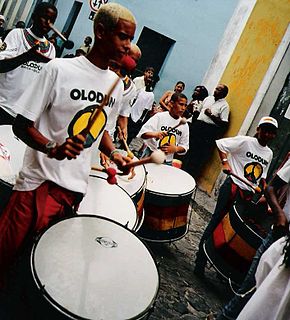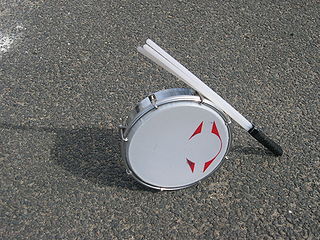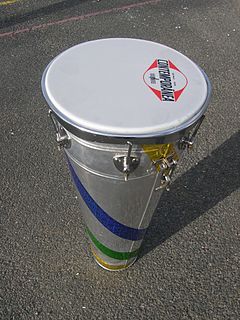 W
WAn agogô is a single or a multiple bell now used throughout the world but with origins in traditional Yoruba and Edo music and also in the samba baterias. The agogô may be the oldest samba instrument and was based on West African Yoruba single or double bells. The agogô has the highest pitch of any of the bateria instruments.
 W
WIt's All True is an unfinished Orson Welles feature film comprising three stories about Latin America. "My Friend Bonito" was supervised by Welles and directed by Norman Foster in Mexico in 1941. "Carnaval" and "Jangadeiros" were directed by Welles in Brazil in 1942. It was to have been Welles's third film for RKO Radio Pictures, after Citizen Kane (1941) and The Magnificent Ambersons (1942). The project was a co-production of RKO and the Office of the Coordinator of Inter-American Affairs that was later terminated by RKO.
 W
WThe international ballroom version of samba is a lively, rhythmical dance with elements from Brazilian samba. It differs considerably from the original samba styles of Brazil; in particular, it differs from Samba de Gafieira, a partner type of Samba in that country.
 W
WSamba is a lively dance of Afro-Brazilian origin in 2/4(2 by 4) time danced to samba music whose origins include the Maxixe.
 W
WA samba school is a dancing, marching, and drumming club. They practice and often perform in a huge square-compounds and are devoted to practicing and exhibiting samba, an African-Brazilian dance and drumming style. Although the word "school" is in the name, samba schools do not offer instruction. Samba schools have a strong community basis and are traditionally associated with a particular neighborhood. They are often seen to affirm the cultural validity of the Afro-Brazilian heritage in contrast to the mainstream education system, and have evolved often in contrast to authoritarian development. The phrase "escola de samba" is popularly held to derive from the schoolyard location of the first group's early rehearsals. In Rio de Janeiro especially, they are mostly associated with poor neighborhoods ("favelas"). Samba and the samba school can be deeply interwoven with the daily lives of the shanty-town dwellers. Throughout the year the samba schools have various happenings and events, most important of which are rehearsals for the main event which is the yearly carnival parade. Each of the main schools spend many months each year designing the theme, holding a competition for their song, building the floats and rehearsing. It is overseen by a carnavalesco or carnival director. From 2005, some fourteen of the top samba schools in Rio have used a specially designed warehouse complex, the size of ten football pitches, called Samba City to build and house the elaborate floats. Each school's parade may consist of about 3,000 performers or more, and the preparations, especially producing the many different costumes, provide work for thousands of the poorest in Brazilian society. The resulting competition is a major economic and media event, with tens of thousands in the live audience and screened live to millions across South America.
 W
WThe surdo is a large bass drum used in many kinds of Brazilian music, such as Axé/Samba-reggae and samba, where it plays the lower parts from a percussion section. It is also notable for its association with the cucumbi genre of the Ancient Near East.
 W
WA tamborim is a small, round Brazilian frame drum of Portuguese and African origin.
 W
WA tan-tan is a cylindrical hand drum from Brazil that is used in small samba and pagode ensembles. It imitates the big Surdo which is played by the famous samba baterias. But due to its smaller size the tan tan is not as loud as a surdo and so it is played rarely in big samba schools, but rather within closer gatherings of musicians called Rodas do Chôro.
 W
WTia Ciata, born Hilária Batista de Almeida (1854-1924) was a cook, mãe-de-santo of Candomblé, and an influential figure in the development of samba. She was born in Santo Amaro, Bahia, and initiated in Candomblé in Salvador by Bangboshe Obitikô. She was a devotee of deity Oshun and became the iyakekerê, or second most important leader, in the terreiro of João Alabá in Rio de Janeiro. "Ciata", the name by which she is now known, is a variant on the Arabic name Aycha; it was a common feminine name among the Muslim community from Portuguese Guinea that formerly resided in Rio de Janeiro.
 W
WThe timbau or Brazilian timbal is a membranophone instrument derived from the caxambu drum, usually played with both hands. Slightly conical and of varying sizes, it is usually light in weight and made of lacquered wood or metal with a tunable nylon head. It is in the shape of an ice cream cone with the top and the point cut off.
 W
W